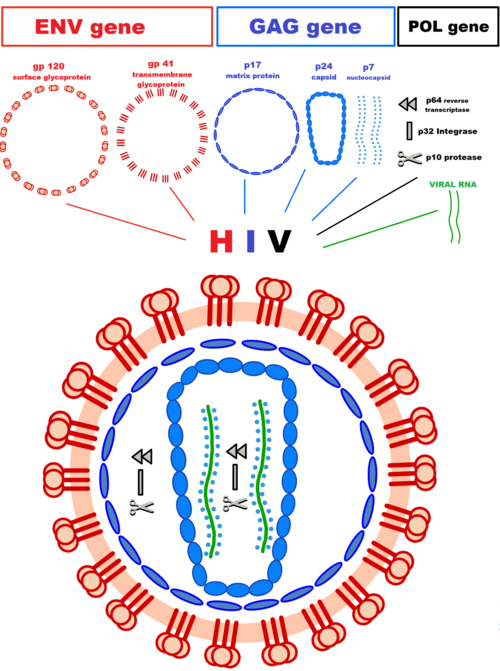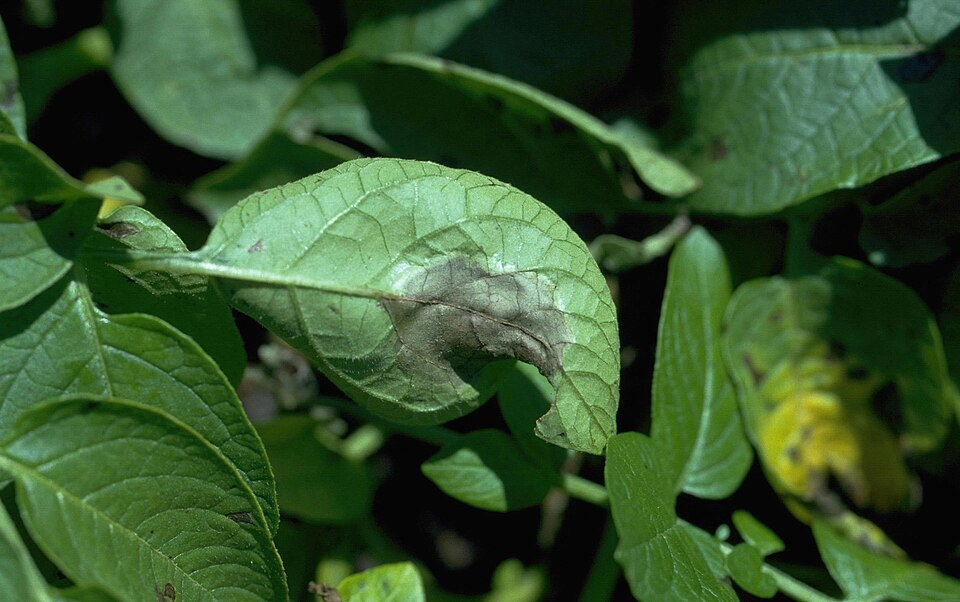OCR Specification focus:
‘Bacteria, viruses, protoctista and fungi cause communicable diseases; include TB, HIV/AIDS, influenza, Tobacco Mosaic Virus, malaria, late blight, ring rot, black sigatoka, and athlete’s foot.’
Communicable diseases are caused by various pathogens that invade and damage host organisms. Understanding their types, structures, and examples is vital for studying infection and immunity mechanisms.
Types of Pathogens
Pathogens are disease-causing microorganisms that disrupt normal physiological processes in their host. The four major groups are bacteria, viruses, protoctista, and fungi. Each group has unique features that influence how they infect and spread.
Bacteria
Bacteria are prokaryotic microorganisms that reproduce rapidly through binary fission, releasing toxins that damage host tissues.
Bacterium: A single-celled prokaryotic organism lacking a membrane-bound nucleus and other organelles.
They can be rod-shaped (bacilli), spherical (cocci), or spiral (spirilla), and are often classified by Gram staining into Gram-positive and Gram-negative groups.
Examples of bacterial diseases include:
Tuberculosis (TB) – caused by Mycobacterium tuberculosis and M. bovis. TB primarily affects the lungs, causing chronic coughing, tissue damage, and impaired gas exchange. It can also spread to other tissues such as lymph nodes or bones. Transmission occurs via droplet infection when an infected person coughs or sneezes.
Bacterial ring rot – caused by Clavibacter michiganensis in potato plants. It destroys vascular tissue, leading to wilting and decay, making crops unsellable and reducing yield drastically.
Bacterial pathogens often produce exotoxins or endotoxins that disrupt host metabolism and trigger inflammation.
Viruses
Viruses are non-cellular infectious agents composed of genetic material (DNA or RNA) enclosed in a protein coat called a capsid.

Labelled diagram of the HIV virion showing envelope glycoproteins and internal capsid surrounding the RNA genome. This visual clarifies how viral structure underpins obligate intracellular replication. The figure also names ENV, GAG, and POL gene products; these gene labels are extra to the syllabus but aid recognition of functional components. Source.
They rely on host cells to replicate, making them obligate intracellular parasites.
Virus: A non-living infectious particle containing nucleic acid surrounded by a protein coat that can only replicate inside a living host cell.
Once inside a host cell, a virus hijacks cellular machinery to produce new viral particles, often destroying the host cell in the process.
Examples of viral diseases include:
HIV/AIDS (Human Immunodeficiency Virus / Acquired Immune Deficiency Syndrome) – HIV infects T helper lymphocytes, gradually weakening the immune system, leaving the body susceptible to opportunistic infections. Transmission occurs through bodily fluids, including blood and semen.
Influenza (flu) – caused by the Influenza virus, which infects the respiratory tract, resulting in fever, muscle pain, and fatigue. It spreads rapidly through droplet infection and can mutate frequently, creating new strains that reduce vaccine effectiveness.
Tobacco Mosaic Virus (TMV) – a plant virus that infects tobacco and other Solanaceae species, causing a characteristic mosaic pattern on leaves due to disrupted chloroplasts, reducing photosynthesis and yield.
Viruses are responsible for some of the most widespread epidemics due to their rapid mutation and high transmission potential.
Protoctista (Protists)
Protoctista, or protists, are eukaryotic microorganisms that often require a vector to transfer them between hosts. Many are parasitic, living inside cells and feeding on their contents.
Protoctist: A diverse group of eukaryotic, often single-celled organisms that are not classified as plants, animals, or fungi. Some are parasitic and cause disease.
Unlike bacteria, protoctista possess a nucleus and membrane-bound organelles, allowing more complex life cycles.
Examples of protoctistan diseases include:
Malaria – caused by Plasmodium species (P. falciparum, P. vivax, etc.), transmitted by the female Anopheles mosquito. The parasite infects red blood cells and the liver, leading to fever cycles, anaemia, and organ damage.
Late blight – caused by Phytophthora infestans, a water mould-like organism (often grouped with protoctista) that devastates tomato and potato crops. It infects leaves and tubers, causing brown lesions and rapid decay.

Potato leaflet showing characteristic brown, water-soaked lesions of late blight caused by Phytophthora infestans. This real-world image helps students recognise typical disease presentation on host leaves. The photograph focuses on symptoms only and avoids life-cycle details not required by the syllabus. Source.
Protoctistan diseases are often controlled by breaking the life cycle of the vector, such as using insecticides or removing breeding sites.
Fungi
Fungi are eukaryotic heterotrophs that absorb nutrients from decaying or living matter. Many are saprotrophic, while pathogenic fungi invade living tissues, secreting enzymes that digest host cells externally.
Fungus: A eukaryotic organism that reproduces by spores and feeds through extracellular digestion of organic matter.
They reproduce via spores, which can survive in harsh conditions and spread through air or water droplets.
Examples of fungal diseases include:
Black sigatoka – caused by Mycosphaerella fijiensis, infecting banana plants, leading to dark streaks on leaves that reduce photosynthesis and yield.

Banana leaf with dark, elongated streak lesions typical of black sigatoka. The image illustrates how fungal infection damages lamina tissue and limits photosynthetic area. No additional management or life-cycle detail is shown, keeping focus on visual diagnosis aligned to the syllabus. Source.
Athlete’s foot – caused by Trichophyton rubrum, a dermatophyte fungus that infects keratinised skin between toes, resulting in itching, cracking, and scaling. It spreads through direct contact or contaminated surfaces.
Fungal infections are particularly damaging in immunocompromised individuals and can also spoil stored food and crops, posing economic risks.
Comparison of Pathogen Characteristics
To appreciate their diversity, note key differences among pathogen groups:
Bacteria: Cellular, prokaryotic, reproduce independently, produce toxins.
Viruses: Non-cellular, require host cells for replication, smallest pathogens.
Protoctista: Eukaryotic, often vector-borne, intracellular parasites.
Fungi: Eukaryotic, produce spores, digest externally before absorption.
These distinctions determine how diseases spread, how the immune system responds, and how they can be treated or prevented. For example, antibiotics target bacterial metabolism but are ineffective against viruses, which lack such pathways.
Summary of Named Examples (Syllabus Focus)
Animal diseases:
Mycobacterium tuberculosis → Tuberculosis (TB)
HIV → AIDS
Influenza virus → Influenza
Plasmodium spp. → Malaria
Trichophyton rubrum → Athlete’s foot
Plant diseases:
Tobacco Mosaic Virus (TMV) → Mosaic patterning and reduced photosynthesis
Phytophthora infestans → Late blight
Clavibacter michiganensis → Ring rot
Mycosphaerella fijiensis → Black sigatoka
These named examples illustrate the diversity of pathogens and the range of species affected, forming the foundation for understanding how diseases spread and how hosts evolve defences.
FAQ
Bacterial toxins interfere with normal cell function, leading to tissue damage and illness.
Exotoxins are proteins secreted by living bacteria that disrupt metabolic pathways or destroy cell membranes. For example, they may block neurotransmission or cause cell lysis.
Endotoxins are lipopolysaccharides found in the outer membrane of Gram-negative bacteria. When these bacteria die, endotoxins are released and trigger fever, inflammation, or shock.
The symptoms experienced in many bacterial infections result from the host’s immune response to these toxins rather than from direct bacterial invasion alone.
Antibiotics target specific bacterial structures or metabolic pathways, such as cell walls, ribosomes, or enzyme systems.
Viruses lack these cellular components because they are non-cellular and rely entirely on the host cell for replication. As a result, antibiotics have no target to act upon.
Instead, antiviral drugs are used, which work by blocking viral attachment, inhibiting replication enzymes, or preventing viral release from host cells. However, developing antivirals is more challenging due to the high mutation rates of viruses.
TMV spreads mainly through mechanical transmission when infected plant material comes into contact with healthy tissue.
It can be transmitted via contaminated tools, hands, or insects feeding on damaged leaves.
The virus is also highly stable, surviving on surfaces and plant debris for long periods.
Once inside, it moves through the plasmodesmata and phloem, allowing rapid systemic infection.
Because TMV is very resilient and cannot be eliminated by heat or chemicals easily, controlling its spread relies on hygiene, resistant plant varieties, and removing infected plants.
The spread of black sigatoka depends on warm, humid conditions, which favour fungal spore germination and dispersal.
Key factors include:
Temperature: Optimal growth occurs between 27–31°C.
Humidity and rainfall: Moist leaf surfaces enable spore germination and infection.
Wind: Assists in spreading airborne spores over long distances.
Agricultural practices such as dense planting and poor air circulation increase humidity and encourage spread. Farmers manage this by fungicide application, pruning, and plant spacing to reduce leaf wetness duration.
Malaria’s distribution is closely linked to the ecology of the Anopheles mosquito, which thrives in tropical climates.
Warm temperatures (around 25–30°C) speed up the Plasmodium life cycle within the mosquito, increasing transmission rates.
High rainfall provides breeding sites for mosquitoes, such as stagnant pools.
Poor housing and lack of mosquito control also increase exposure.
In contrast, colder climates slow parasite development or prevent mosquito survival, making malaria rare outside tropical and subtropical zones.
Practice Questions
Question 1 (2 marks)
State two structural differences between bacteria and viruses.
Mark scheme:
1 mark for each correct structural difference (maximum 2 marks):
Bacteria are cellular (prokaryotic cells) whereas viruses are non-cellular.
Bacteria have cytoplasm and a plasma membrane; viruses have only a protein coat (capsid) surrounding genetic material.
Bacteria contain DNA and ribosomes; viruses contain DNA or RNA but no ribosomes.
Bacteria can reproduce independently; viruses require a host cell to replicate.
Question 2 (5 marks)
Compare and contrast the modes of infection and effects on hosts of Mycobacterium tuberculosis (causing TB) and Plasmodium species (causing malaria).
Mark scheme:
Award up to 5 marks as follows:
1 mark: Correct identification of Mycobacterium tuberculosis as a bacterium and Plasmodium as a protoctist (protist).
1 mark: TB is transmitted by droplet infection (inhalation of bacteria in airborne droplets) whereas malaria is transmitted by a vector, the female Anopheles mosquito.
1 mark: TB infects the lungs, damaging alveolar tissue and causing coughing and impaired gas exchange.
1 mark: Plasmodium infects liver and red blood cells, causing fever cycles, anaemia, and damage due to cell lysis.
1 mark: Contrast or comparison showing understanding of different life cycles or host requirements, e.g. Plasmodium requires both mosquito and human hosts, whereas Mycobacterium tuberculosis spreads directly between humans.

